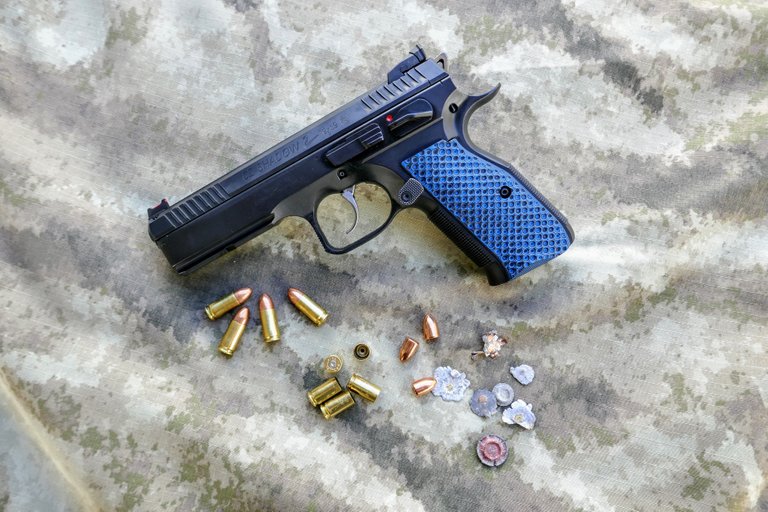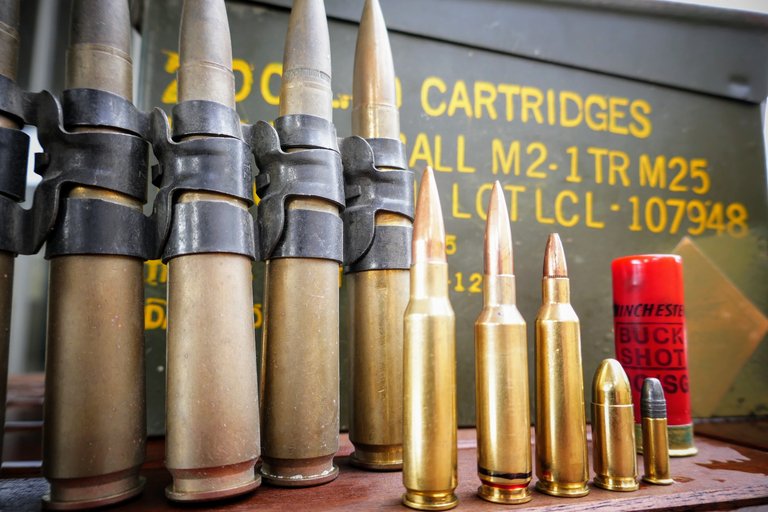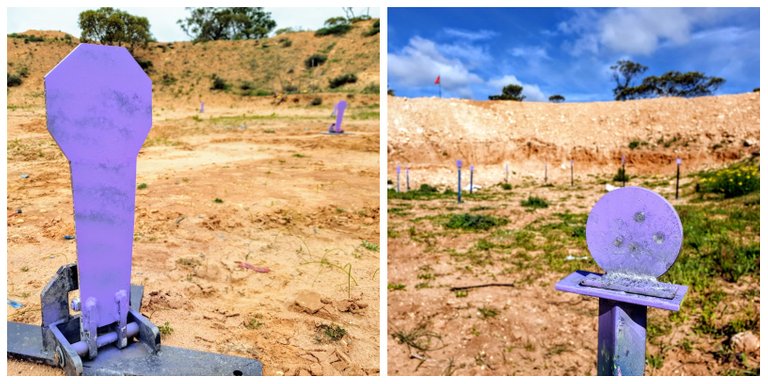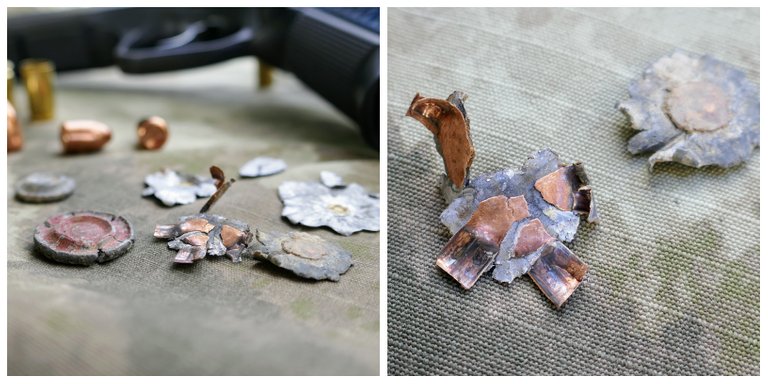Hit it at one thousand kilometres per hour
What do you think would happen to you if you hit a steel wall whilst travelling at one thousand kilometres per hour? - Make a mess you think? Fortunately most of us never find out the answer to that question although I happen to have a few things that have indeed hit a steel wall at about that speed and I thought I'd share them with you in a post.
As some of you know I own and shoot guns competing around the country in various practical-oriented rifle and handgun competitions - It's one of my hobbies and a sport at the same time. Some of you probably have an idea about guns and the various concepts that come into play but many do not so every so often I roll out a gun-post to introduce or explain a concept, or just show you something cool. It's ok if you tune out right now, if you don't like guns, however this is not really about guns per se, more about lead and what happens to it when it hits something hard and at speed.

Projectiles or bullets
Some people call these things bullets but to me they are projectiles. It is the part of the round that exits the gun and flies through the air towards its intended target. You can see some below. I make my own rifle and handgun ammunition and so buy my 9mm projectiles in boxes of 1000, normally 5,000 at a time, which is about what I'd shoot in about a year. Just a note on ammunition. Correct terminology is ammunition or round. The word bullet relates to the component fired from the firearm only, as above.
I use 124gn CMJ projectiles. The CMJ part refers to the copper jacket or plating the formed lead projectile is covered in. It means I'm handling less exposed-lead and they also run a lot cleaner through my handguns - They leave less lead residue in the firing process. The 124gn part is the weight of the projectile. A grain (gn) is a measurement.

Left image above shows a few projectiles and spent cases. You can just see the depression in the primer of one [very left of image] which is where the firing pin has struck it to set off the process of explosions that fire the round. You can also see the copper-jacketed [plated] projectiles.
A word on muzzle velocity
The term muzzle velocity relates to the speed at which a projectile exits the muzzle. The muzzle being the very end part of the barrel - Essentially the hole in the end of the gun, to make it extremely simple. So, muzzle velocity is speed and typically it is measured in feet per second (fps). My CZ Shadow-2 9mm pushes the 124gn projectiles at between 985 and 1050 fps, so pretty fast. For the purpose of this post I've averaged it out at 1000fps which is 1097.28kph or 681.818mph if you're American. It's fast.
Just as a side note, I run my rifles at around 2850fps and 3200fps depending on calibre so a great deal faster. Obviously rifles are designed to reach greater distances and require the additional speed. More gun powder is used of course, which is why rifle cases are bigger than handgun cases. The image below demonstrates this better than I could explain. The heavier the projectile, the more gun powder required to exit it effectively from the muzzle.

Left to right - 50cal, .308, 6.5mm Creedmoor, .223/5.56, 9mm, .22LR and 12 gauge shotgun - These are all my rounds and cover most of the calibre's I shoot.
When shooting IPSC as I was today we shoot at various targets including torso-shaped cardboard and steel plates. When a projectile hits cardboard it obviously cuts right through and heads away and into the backstop mound. When it hits steel though it stops after imparting its energy into the steel. These steel targets, when struck, generally fall or flip back indicating a hit; They also make a satisfying noise.

Above you can see a couple of steel targets, one hinged on the left and the other a simple falling plate. These are not designed for handgun use though as the steel gauge is too thin. These are used for .22LR rimfire use only and I show then just as an example.
Smacking steel with lead
So, now to the cool part. What happens to a projectile when it smacks into a steel target?
The answer to this is not quite as straight forward as you may think; Essentially it comes down to physics. A small lead projectile on a heavy gauge steel plate will pulverise to dust, a heavy projectile on a light gauge steel target will deform - Generally. It comes down to muzzle velocity also, faster or slower I mean, and also range at which it was fired as projectiles slow the farther they travel. The actual target comes into play too. One that tumbles backwards similar to the one above right will offer less resistance to the bullet and cause it to deform less. Again, there are many variables. Mostly projectiles strike the steel target and are pulverised into nothing.

This very heavy projectile above has hit steel and deformed significantly. You can see the inner ring, above left, which is actually the base of the projectile. The image to the right shows the front of the projectile, the part that has hit the target. You can see it has mushroomed as the back of the bullet followed the front in until it had no energy left.

This is a projectile from a .38 Super handgun and was shot today by one of my friends. It is totally flattened out rather than "mushroomed" and in the left image you can see the round circle which is the base of the projectile. The right shows the front of the projectile which hit the target first. You can see a little residue right in the centre which is left from the copper jacket.

Above are a few projectiles I picked up today, of various types. You can see how flat they become and the right image shows one that is quite mangled. You can see the lead and the copper jacket all mangled together and I can only assume that this bullet was travelling a lot slower as it is not completely flattened out; You can clearly see the copper jacket which encased the lead projectile.
That's pretty much it for today. I always try to make these posts as easy to follow as possible preferring not to get too technical. It's difficult though because shooting sports and shooting in general, is quite a technical and complicated thing when one delves into it. Sure, I could hand you a loaded firearm and you could shoot it, but to be accurate, fast, and able to shoot over great distances takes a lot of effort and understanding - That's not to mention all the back-end work that goes into shooting: Making ammunition, setting up scopes, learning ballistics calculators, working range finders, calling the wind, load development...Loads more too. I've written posts about various things in the past and have linked to just a few below if you're interested.
Getting DOPE
Seeing at 788m
Perception and reality
Too much wind
Getting painted
Shooting on a cant
No luck
Range finder
Long range shooting
A comp
Getting level
For now though I hope this one was interesting, or at least informative in a non-technical and easy to follow way.
Design and create your ideal life, don't live it by default
I like your gun posts, mate. Keep it up. Proper informative!
Thanks Boom. Showing people some of the concepts behind guns and that it's not about shooting coke cans and blasting pumpkins in a drunken stupor is what I'm trying to do. I hope I'm succeeding, and managing to present as an informed and knowledgeable gun owner.
Posted using Partiko Android
You are indeed, that's what I like about em. It's not all, yeehaaaw and them critters are getting it if they look me the wrong way
I'm hitting the mark then. 😁
Posted using Partiko Android
Congratulations @galenkp! You have completed the following achievement on the Steem blockchain and have been rewarded with new badge(s) :
You can view your badges on your Steem Board and compare to others on the Steem Ranking
If you no longer want to receive notifications, reply to this comment with the word
STOPTo support your work, I also upvoted your post!
Do not miss the last post from @steemitboard:
Vote for @Steemitboard as a witness to get one more award and increased upvotes!
Wow, never had really seen these! No wonder they destroy our soft bodies!
Posted using Partiko iOS
Projectiles are designed to do different things when they hit flesh. Sometimes they mushroom out for maximum damage and knock-down as in most hunting applications and other times they are designed to simply wound - I think the principle is that a wounded soldier needs a medevac and that means helicopters and other soldiers to carry the wounded. More targets. Also, wounded men slow a fighting force and can demoralise also. There's many reasons for it. It's a brutal way of doing war. Google flechette and read about those projectiles. Brutal.
Of course, for my sporting purposes they are designed to reach the target accurately, in the last possible time and causing the last possible recoil which means subsequent shots are quicker and also accurate. Managing recoil is key which is why minimum power factors are set for competitors.
In my hunting and culling duties I select the correct projectile for the job at hand which is very important for the humane dispatch of an animal.
Anyway yes, one wouldn't want to get hit by a bullet I think...Wouldn't feel so good.
Yum, lead and copper pancakes for breakfast. My favorite!
I would have had a sob if you didn't comment! 😁
Posted using Partiko Android
Good explanations of the details behind the sport. I know about it (though not an expert), but feel like even the average person could understand better as a result.
One thing I didn't realize was that you still measured in fps in Australia. That must be an interesting conversion to make when you need to know how far/fast it's going.
Yes the fps thing is curious isn't it, considering we've been metric for years. I also call the wind in mph, but measure range in metres. Odd huh?
Posted using Partiko Android
Wow thanks for sharing! I want that CZ Shadow I just can't afford it. How would the CZ P-09 compare to the Shadow? It seems all the CZ guns have real good accuracy for the most part with the 75 being the most popular. I'm just going to be happy with my P-09.
I have a P-09 also which I really like. Being polymer it is much lighter which means it doesn't handle recoil as well as the Shadow 2. Also I found that the front sight post on the P-09 is too thick and high making long range shots more difficult as the more elevation required the more the target became obscured by the front sight. This can be rectified of course but I wanted to leave mine standard.
The P-09 is a good duty handgun, designed for the military and to work in all conditions and primarily at close range, clearing rooms. In competition sometimes we have to shoot at quite long ranges and it was becoming difficult hence the change to the Shadow 2. I still love my P-09 though and it's a great gun to own.
Be happy with yours mate, they're a good thing. Accurate and fast.
Posted using Partiko Android
Hi @galenkp!
Your post was upvoted by @steem-ua, new Steem dApp, using UserAuthority for algorithmic post curation!
Your UA account score is currently 4.666 which ranks you at #1727 across all Steem accounts.
Your rank has not changed in the last three days.
In our last Algorithmic Curation Round, consisting of 92 contributions, your post is ranked at #49.
Evaluation of your UA score:
Feel free to join our @steem-ua Discord server